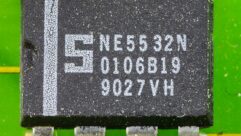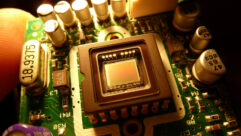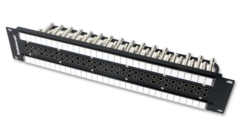long lines: for audio or video
Oct 1, 1999 12:00 PM,
Bill Whitlock
How do we distinguish between short and long when it comes to signal cablesor lines? What really matters is whether the cable is electrically short orlong, which depends on the working frequency range or, more precisely, thehighest frequency present in a normal signal.
Wavelength and transmission lines
Electromagnetic signals travel through space at the velocity of light or186,273 miles per second (299,899 km per second). The time required for acomplete signal cycle determines a distance called wavelength. Consider a20 kHz audio signal. A complete cycle occurs in 1/20 kHz or 50 ms. In thisperiod, the signal will travel 9.31 miles or 49,157 feet (15 km) in space.This is the signal’s wavelength in space. Propagation velocity in a cablevaries according to its construction, but is generally about 70% to 90% ofthat in space. Therefore, a 20 kHz signal would have a wavelength intypical cable of about 39,000 feet (11.9 km).
When signals flow in cables, some energy is stored in the electric andmagnetic fields within and surrounding the cable. This energy propagatesalong the length of the cable, forming a transmission line. Such effects asreflections, standing waves or frequency response ripples will occur unlessthis energy is absorbed at each physical end of the cable. Depending on itsconstruction, every cable has a characteristic impedance, which is theimpedance required to perfectly absorb the energy or terminate each end. Asa general rule, transmission line effects are considered insignificant whenthe length of the cable is less than 1/10 wavelength at the highest signalfrequency. For audio signals in typical cable, this is about 3,900 feet(1,189 m). For a video cable handling 5 MHz bandwidth signals, it is about15 feet (4.6 m). For CATV cable handling 500 MHz bandwidth signals, it isabout 2 inches (51 mm). Any cable longer than this will requiretermination, such as the 75 V usuall!y present at inputs and outputsof video and RF equipment. Unless they are extraordinarily long, however,audio cables do not require termination.
Line drivers and cable capacitance
Cable capacitance is the dominant problem for audio lines more thanapproximately 100 feet (30 m) long. As shown in Figure 1, a low-pass filteris formed by the driver’s output impedance and the capacitance of thecable. The bandwidth of this filter becomes lower as output impedance andcable length increase. It is especially important to consider that typicalunbalanced (RCA jack) consumer equipment can have a 1 kV or higher outputimpedance (not usually specified either). The bandwidth is f = 1 (2pinfinity R infinity C), where f is the -3 dB frequency in Hz, R is thedriver output impedance in ohms, and C is the cable capacitance in farads.For example, consider an unbalanced consumer output, where R = 1 kV, whichdrives 200 feet of 50 pF/ft cable where C = 10 nF. In this example,response will be down 3 dB at 16 kHz. Another example would be a balancedpro output, where R = 200 V, which drives 3,000 feet of 18 pF/ft shieldedtwisted-pair cable where C = 54 nF. In this exam!ple, response will be down 3 dBat 14 kHz.
In either example, lowering drive impedance or lowering cable capacitancewill proportionately increase bandwidth. As a rule of thumb, for these (orany single-pole) filters, response will be down 0.25 dB at ??? of f anddown 1 dB at degree of f.
Another, less recognized, problem associated with cable capacitance islimited driver output current. As the signal voltage swings, the linedriver must supply current to charge and discharge the cablecapacitance.The current required increases with both signal amplitude and frequency.Therefore, with long cables, the line driver can be forced into currentlimiting during cymbal crashes or similar high-level, high-frequencyprogram material. Even if limiting does not actually occur, intermodulationdistortions can be greatly increased under these conditions. Unbalanceddrivers do not generally suffer from current limiting for two reasons.First, they operate at lower signal levels and, consequently, require lesscurrent drive. Second, their higher output impedances usually limit cablelengths for reasons of bandwidth before current capability becomes an issue.
The peak current required by the line driver can be calculated if cablecapacitance, maximum signal amplitude, and maximum signal frequency areknown. For a given capacitance, charging current is directly proportionalto the voltage rate of change or slew rate. For a sine wave, SR = 2pinfinity f infinity Vp where SR is slew rate in volts per second, f isfrequency in Hz, and Vp is peak signal voltage in volts. For example, a 14V peak (10 V RMS = +22 dBu) sine wave at 20 kHz has a slew rate of1,760,000 V per second or 1.76 V per microsecond (2p infinity 20,000infinity 14). Using our previous pro output example, where C = 54 nF, thedriver will have to supply 95 mA to drive just the cable capacitance to +22dBu at 20 kHz. Any additional loading, such as a termination resistor, willrequire even more current. Very few ICs are capable of this current, eventhose specified to drive 600 V loads, which requires only 23 mA to reach+22 dBu. Discrete output stages, like the 250 mA !design in the Jensen/Hardy 990 op-amp module, are recommended for high-performance long-line drivers.
If a high current line driver is impractical, consider a couple ofalternatives. On balanced or unbalanced lines, use a 2:1 step-downtransformer between the driver and the long line. This reduces the drivecurrent requirement to a quarter of its previous value but reduces signallevel by only 6 dB. If an extra 6 dB of gain is available at the receiveend, the original level can be restored, if necessary. Another approach forbalanced lines is to install a 20 dB resistive pad between the driver andthe long line. This will result in reference levels around -20 dBu on theline, which can then drive a mic input at the destination. Properly chosenresistors in the pad can make it appear as a 1 kV load to the driver and a100 V source to the mic preamp, effectively isolating the driver from theeffects of the cable’s capacitance.
Ground noise and interference
Simply because of the physical distances involved, significant groundvoltage differences between driver and receiver are almost certain withlong lines. Ground voltage differences, because they are generated bynormal power line leakage currents, are heard as a noisy mix of hum, buzz,pops, clicks and other rude noises, which I collectively call “groundnoise.” Unbalanced lines are susceptible to enormous problems in thisregard because the ground noise across the length of the shield couplesdirectly into the received signal [ref 1]. This coupling, however, iseasily eliminated by installing a transformer-based ground isolator at thereceive end of the cable run, which stops ground noise current flow in theshield. Another benefit of the isolator is that the line can be driven byeither a balanced or unbalanced source. If an unbalanced output is to drivea balanced input, always use shielded twisted pair (balanced) cable,connecting signal low and shield to each other only a!t the unbalanced output end. This will result in 20 dB to 30 dB more ground noise rejection than usingshielded single conductor (unbalanced) cable and connecting signal low toshield at the balanced input end [ref 2].
In balanced interfaces, ground noise appears at the receive end of the lineas a common-mode voltage. With long lines, ground noise voltage can be highenough to exceed the common-mode limits of the receiver. When this happens,the receiver completely loses its rejection (or CMRR), and the result isusually extremely loud noise. Because the ground noise is highly dependentupon loads and switching in the electrical power environment, this behavioris most often intermittent.
Long lines also increase the chances of interference pickup from nearbymagnetic fields. Twisting of the cable’s signal conductors along its entirelength is usually sufficient to eliminate this almost completely. Butremember that wherever the twisting is opened up, the resulting loopbecomes a magnetic pickup. This applies to wiring at terminal strips andeven XLR connectors. Keep signal cables as far as possible from the strongmagnetic fields radiated by power transformers, motors, televisions orcomputer CRTs, and electrical wiring. Always try to avoid running signalcables parallel to power cables – cross them at right angles wheneverpossible.










